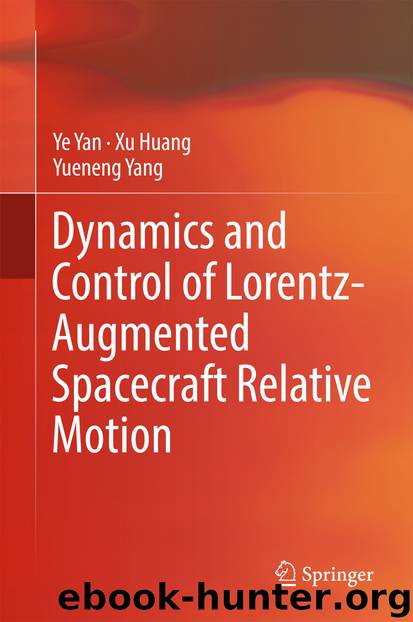Dynamics and Control of Lorentz-Augmented Spacecraft Relative Motion by Ye Yan Xu Huang & Yueneng Yang

Author:Ye Yan, Xu Huang & Yueneng Yang
Language: eng
Format: epub
Publisher: Springer Singapore, Singapore
4.2.3.1 Equatorial Circular Orbit with Nontilted Dipole
The target is assumed to be flying in an equatorial circular orbit with an orbital altitude of 500 km. As discussed in Sect. 4.2.1.1, for this case, the specific charge of Lorentz spacecraft necessary for hovering is irrelevant to the hovering azimuth. Therefore, the required specific charges for different pairs of hovering distance and elevation at this orbital altitude are shown in Fig. 4.5. For example, if the chaser hovers radially above the target by 5 km (i.e., km and ), the necessary specific charge is about C/kg. As shown in Fig. 4.5, the specific charge necessary for hovering generally increases with increasing hovering distance. Furthermore, for hovering in close proximity, the critical elevation is about zero. When , the necessary specific charge is positive, and when , the necessary specific charge is negative, verifying the validity of Eq. (4.24). Given that the near-term feasible maximal specific charge is about C/kg, then the corresponding near-term feasible hovering configurations are shown by the shaded areas in Fig. 4.5.
Fig. 4.5Required specific charges for different hovering distances and elevations. Reprinted from Ref. [1], Copyright 2013, with permission from Elsevier
Download
This site does not store any files on its server. We only index and link to content provided by other sites. Please contact the content providers to delete copyright contents if any and email us, we'll remove relevant links or contents immediately.
| Automotive | Engineering |
| Transportation |
Whiskies Galore by Ian Buxton(41532)
Introduction to Aircraft Design (Cambridge Aerospace Series) by John P. Fielding(32890)
Small Unmanned Fixed-wing Aircraft Design by Andrew J. Keane Andras Sobester James P. Scanlan & András Sóbester & James P. Scanlan(32574)
Craft Beer for the Homebrewer by Michael Agnew(17935)
Turbulence by E. J. Noyes(7702)
The Complete Stick Figure Physics Tutorials by Allen Sarah(7143)
Kaplan MCAT General Chemistry Review by Kaplan(6597)
The Thirst by Nesbo Jo(6439)
Bad Blood by John Carreyrou(6277)
Modelling of Convective Heat and Mass Transfer in Rotating Flows by Igor V. Shevchuk(6225)
Learning SQL by Alan Beaulieu(6037)
Weapons of Math Destruction by Cathy O'Neil(5831)
Man-made Catastrophes and Risk Information Concealment by Dmitry Chernov & Didier Sornette(5650)
Digital Minimalism by Cal Newport;(5391)
Life 3.0: Being Human in the Age of Artificial Intelligence by Tegmark Max(5187)
iGen by Jean M. Twenge(5163)
Secrets of Antigravity Propulsion: Tesla, UFOs, and Classified Aerospace Technology by Ph.D. Paul A. Laviolette(4993)
Design of Trajectory Optimization Approach for Space Maneuver Vehicle Skip Entry Problems by Runqi Chai & Al Savvaris & Antonios Tsourdos & Senchun Chai(4843)
Electronic Devices & Circuits by Jacob Millman & Christos C. Halkias(4748)
